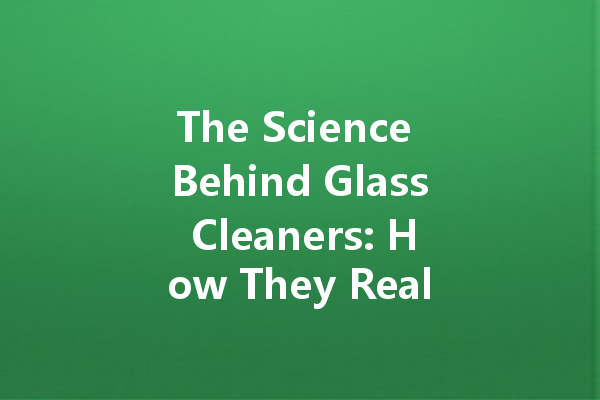Glass cleaners play a crucial role in maintaining clean and sparkling surfaces around our homes, offices, and vehicles. But have you ever wondered about the science behind these seemingly simple cleaning solutions? Let’s delve into the fascinating world of glass cleaners and uncover how they really work.
Understanding the Formulation
Glass cleaners contain a combination of ingredients carefully formulated to tackle dirt, grime, and smudges effectively. The primary components typically include water, solvents, detergents, and surfactants. These ingredients work together to break down and lift away contaminants from the glass surface.
The Role of Solvents
Solvents in glass cleaners serve the purpose of dissolving tough residues such as grease, oil, and adhesive substances. Common solvents like isopropyl alcohol or ammonia are effective in cutting through stubborn stains, allowing the limpiador to wipe them away easily.
Surfactants for Surface Tension
Surfactants are essential ingredients that reduce the surface tension of water, enabling the cleaner to spread evenly across the glass surface. By lowering the surface tension, surfactants help the solution penetrate and lift off dirt and grime more effectively.
Detergents for Cleaning Power
Detergents in glass cleaners work to break down oily residues and dirt particles, making them easier to rinse away. These compounds bind to the dirt on the glass, allowing it to be wiped off cleanly without streaking.
Anti-Streak Agents

To achieve that streak-free finish we all desire, glass cleaners often contain anti-streak agents. These additives help prevent the formation of streaks and ensure a crystal-clear result after cleaning.
Fragancias y colorantes
While not essential to the cleaning process, fragrance and colorants are often added to glass cleaners to enhance the user experience. These elements provide a pleasant scent and visual appeal, making the cleaning process more enjoyable.
How Glass Cleaners Work in Action
When a limpiacristales is sprayed onto a surface, the combination of solvents, surfactants, detergents, and other ingredients goes to work. The solvents dissolve tough residues, while surfactants lower the surface tension of water, allowing the cleaner to spread evenly. Detergents break down dirt and grime, and anti-streak agents ensure a streak-free shine.
Consideraciones medioambientales
While effective in cleaning glass surfaces, some traditional glass cleaners contain chemicals that may pose risks to the environment. As awareness of environmental impact grows, many manufacturers are now producing eco-friendly glass cleaners that are biodegradable and safer for use.
Conclusión
In conclusion, the science behind glass cleaners is a careful balance of ingredients designed to tackle dirt and grime effectively while leaving glass surfaces sparkling clean. By understanding how these components work together, you can make informed choices when selecting the right glass cleaner for your cleaning needs. Remember to consider environmental factors and opt for eco-friendly options when possible to maintain a clean home while minimizing impact on the planet.
